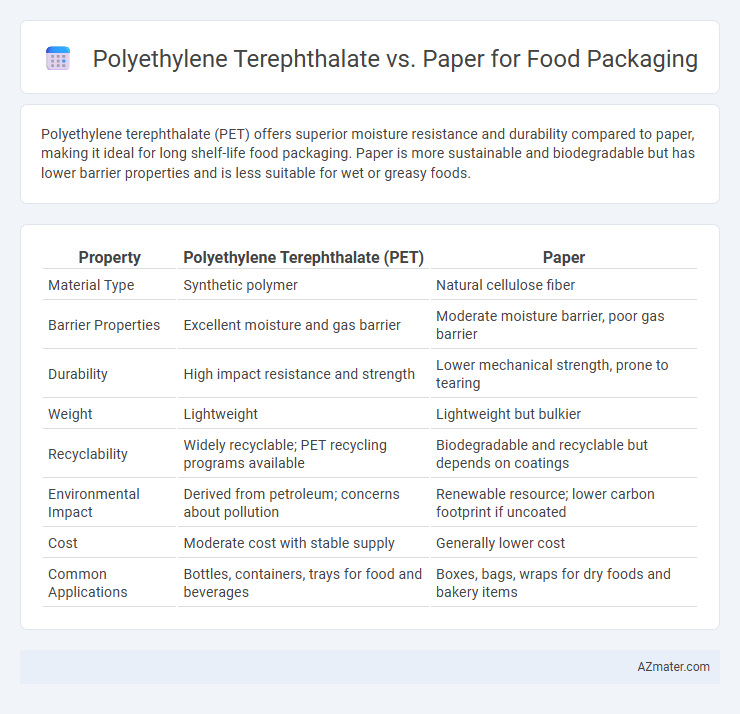Polyethylene terephthalate (PET) offers superior moisture resistance and durability compared to paper, making it ideal for long shelf-life food packaging. Paper is more sustainable and biodegradable but has lower barrier properties and is less suitable for wet or greasy foods.
Table of Comparison
| Property | Polyethylene Terephthalate (PET) | Paper |
|---|---|---|
| Material Type | Synthetic polymer | Natural cellulose fiber |
| Barrier Properties | Excellent moisture and gas barrier | Moderate moisture barrier, poor gas barrier |
| Durability | High impact resistance and strength | Lower mechanical strength, prone to tearing |
| Weight | Lightweight | Lightweight but bulkier |
| Recyclability | Widely recyclable; PET recycling programs available | Biodegradable and recyclable but depends on coatings |
| Environmental Impact | Derived from petroleum; concerns about pollution | Renewable resource; lower carbon footprint if uncoated |
| Cost | Moderate cost with stable supply | Generally lower cost |
| Common Applications | Bottles, containers, trays for food and beverages | Boxes, bags, wraps for dry foods and bakery items |
Introduction to Food Packaging Materials
Polyethylene terephthalate (PET) and paper are widely used food packaging materials, each offering distinct properties suited for different applications. PET is a durable, lightweight plastic known for its excellent barrier against moisture and oxygen, extending the shelf life of packaged goods. In contrast, paper provides a biodegradable, renewable option with good printability and breathability, but typically requires coatings or laminates to enhance its protective performance for food packaging.
What is Polyethylene Terephthalate (PET)?
Polyethylene terephthalate (PET) is a widely used thermoplastic polymer known for its strength, transparency, and excellent barrier properties against moisture and gases, making it ideal for food packaging. PET is highly favored for its recyclability and ability to preserve the freshness and shelf life of food products compared to traditional paper packaging. Its lightweight nature and durability provide superior protection, reducing contamination risks and extending product quality without compromising environmental sustainability.
Overview of Paper as a Food Packaging Material
Paper as a food packaging material offers sustainability advantages due to its biodegradability and recyclability, making it a preferred choice for environmentally conscious brands. It provides excellent printability and versatility, allowing for diverse packaging designs and effective branding opportunities. However, paper typically requires coatings or lamination to achieve moisture resistance and barrier properties comparable to polyethylene terephthalate (PET), which can impact its recyclability and compostability.
Barrier Properties: Moisture and Oxygen Resistance
Polyethylene terephthalate (PET) offers superior moisture and oxygen barrier properties compared to paper, making it highly effective in preserving food freshness and extending shelf life. While paper provides limited protection against oxygen and moisture, its permeability can lead to faster food spoilage and reduced quality. PET's dense polymer structure significantly reduces gas and water vapor transmission rates, enhancing its barrier performance in food packaging applications.
Environmental Impact and Sustainability
Polyethylene terephthalate (PET) offers durability and recyclability but relies on fossil fuels, contributing to greenhouse gas emissions and plastic pollution, while paper packaging is biodegradable and sourced from renewable materials, enhancing compostability and reducing landfill waste. The production of paper packaging involves significant water and energy use, occasionally resulting in deforestation when sourced unsustainably, whereas PET recycling systems are more established but challenged by contamination issues. Evaluating life cycle assessments, paper often demonstrates superior compostability and lower end-of-life environmental impact, yet PET's lightweight and higher strength can reduce transportation emissions, highlighting trade-offs in sustainability metrics.
Food Safety and Chemical Migration Concerns
Polyethylene terephthalate (PET) offers superior food safety due to its inert nature and excellent barrier properties, significantly reducing the risk of chemical migration into food compared to paper packaging. Paper, often requiring coatings or additives for moisture resistance, poses higher potential for chemical leaching and contamination, especially when in contact with fatty or acidic foods. Regulatory standards such as FDA and EFSA emphasize the importance of using materials like PET that minimize migration of hazardous substances, ensuring safer food packaging solutions.
Cost Analysis: PET vs Paper Packaging
Polyethylene terephthalate (PET) packaging generally incurs higher initial material and manufacturing costs compared to paper packaging due to its complex polymer production and processing requirements. However, PET offers greater durability, moisture resistance, and longer shelf life, potentially reducing overall costs linked to product spoilage and replacement. Paper packaging, while more cost-effective upfront and biodegradable, may necessitate additional treatments or coatings that can increase expenses and compromise environmental benefits.
Consumer Perception and Market Trends
Polyethylene terephthalate (PET) is perceived by consumers as a convenient, durable, and transparent material enhancing product visibility, while paper packaging appeals due to its eco-friendly, biodegradable qualities aligning with rising sustainability concerns. Market trends reveal a growing demand for recyclable and compostable packaging solutions, driving food brands to increasingly adopt paper-based materials despite PET's dominance in barrier protection and shelf-life extension. Consumer preference shifts toward environmentally responsible packaging have stimulated innovation in paper coatings to improve performance, bridging the gap with PET without sacrificing sustainability credentials.
Recycling and End-of-Life Management
Polyethylene terephthalate (PET) offers high recyclability with established global infrastructure enabling efficient mechanical recycling, producing high-quality recycled pellets for food packaging applications. Paper packaging, while biodegradable and compostable, faces challenges in recycling due to contamination with food residues and the presence of coatings that hinder fiber recovery. End-of-life management favors PET in circular economy systems due to its closed-loop recyclability, whereas paper's biodegradability supports composting but often leads to downcycling or landfill disposal if not properly sorted.
Choosing the Right Material for Food Packaging
Polyethylene terephthalate (PET) offers superior moisture resistance, durability, and clarity, making it ideal for packaging perishable foods requiring extended shelf life and product visibility. Paper, on the other hand, excels in biodegradability and sustainability but may lack sufficient barrier properties against grease and moisture, limiting its use for certain food applications. Selecting the right material depends on balancing factors such as environmental impact, food protection requirements, and regulatory compliance specific to the product type.

Infographic: Polyethylene terephthalate vs Paper for Food Packaging
 azmater.com
azmater.com